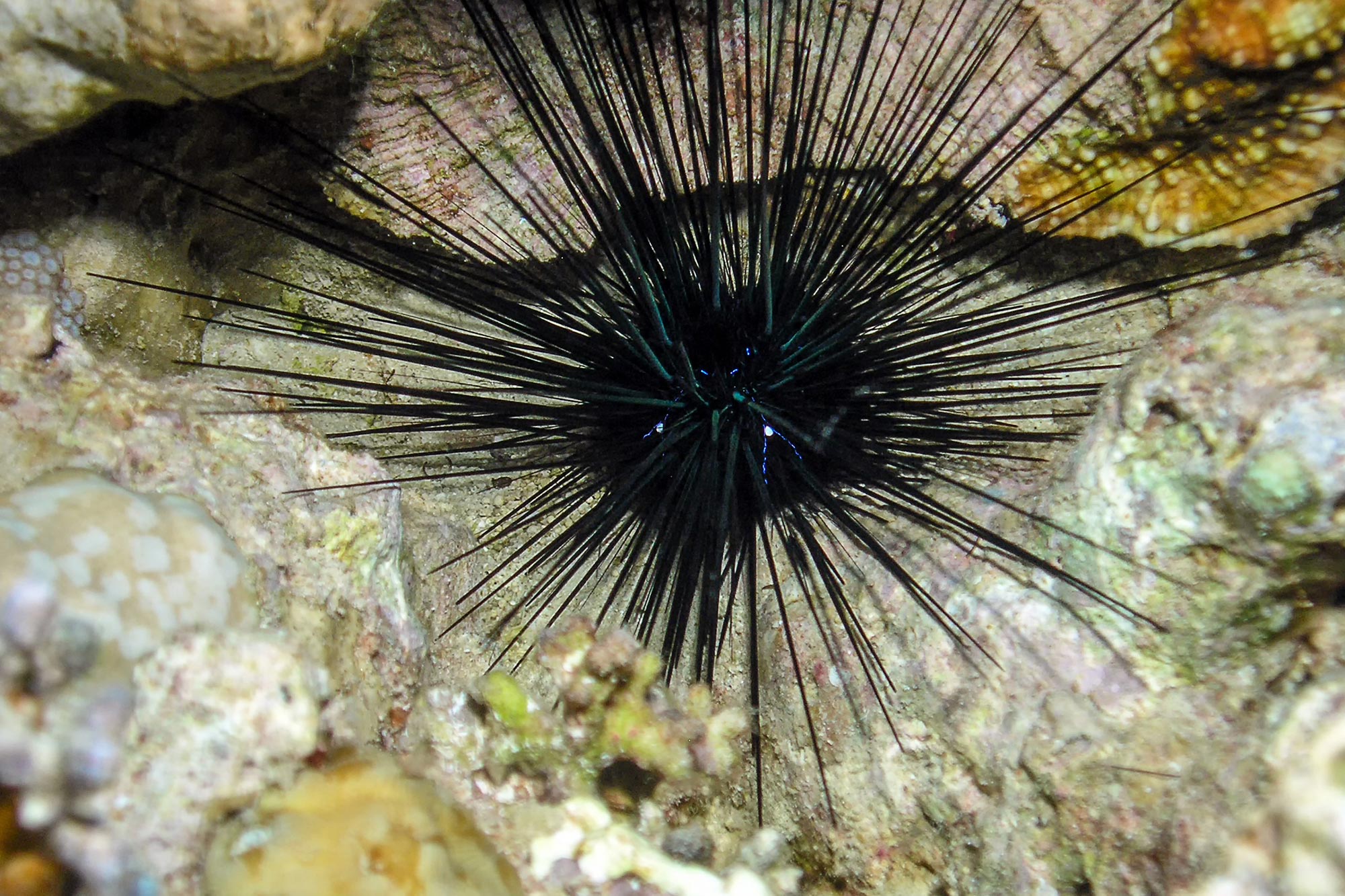

Egysejtű szervezetet, a scuticocilitet azonosították a hosszú tüskés tengeri sünök 2022-es tömeges elpusztulásának okaként a Karib-térségben és Florida keleti partvidékén. Ezek a sünök nélkülözhetetlenek a korallzátonyok egészségéhez, és a felfedezés kérdéseket vet fel a csillós állatok jelenlétével, növekedési körülményeikkel és más fajokra gyakorolt lehetséges hatásukkal kapcsolatban. Fénykép a hosszú, tüskés tengeri sünről (Diadema antillarum).
A hosszú tüskés tengeri sün tömeges pusztulását – amely veszteség a Karib-tengertől Florida keleti partjáig terjedő korallzátonyok egészségét fenyegeti – egy csillósnak nevezett egysejtű szervezet okozta.
2022-ben véget ért a gyilkos utáni vadászat, amely kiirtotta a hosszú tüskés tengeri sünököt a Karib-térségben és Florida keleti partjai mentén. Mia Breitbart, a Dél-Floridai Egyetem Tengertudományi Főiskolájának kiváló egyetemi professzora által szervezett kutatócsoport egy ciliárisnak nevezett egysejtű szervezetet azonosított a korallzátonyok egészsége szempontjából létfontosságú tengeri állat tömeges elpusztulásának okaként.
Eredményeiket április 19-én tették közzé a Nature folyóiratban
Ciliate culture viewed under the microscope. Credit: Mya Breitbart USF College of Marine Science
“We’re beyond thrilled to get to the bottom of the 2022 mystery and a bit stunned we did it so quickly,” said Breitbart, senior author on the Science Advances study and an expert in marine genomics. “We had a great team in place and the tools needed to do the ocean science equivalent of a forensic investigation.”
Ciliates are microscopic organisms covered in hair-like structures called cilia that help them move and eat. They are found almost anywhere there is water and most are not disease-causing agents. However, this specific species of ciliate – called a scuticociliate – has been implicated in die-offs of other marine species, such as sharks, in the past.

Photo compilation showing the same sea urchin before and after infection with the ciliate in the USF aquarium research facility. Credit: Makenzie Kerr USF College of Marine Science
Examining urchins collected from 23 sites in the Caribbean, the research team used a series of techniques to confirm the source of the die-off event.
After identifying the ciliate in every affected urchin specimen using genomic techniques, the team grew ciliates in the lab and performed infection experiments at the USF College of Marine Science. When the pathogen was introduced to otherwise healthy urchins in an aquarium tank, the urchins died within a few days – replicating what was taking place in the ocean and confirming the ciliate as the disease source.

DaSc-affected sea urchin, Aruba, August 2022. Credit: Ian Hewson Cornell University
“We’re excited to share this information with everyone, from reef managers to additional scientists so we can explore it further and try to stop its spread,” Breitbart said.

Mya Breitbart (USF) viewing the ciliate culture by microscopy. Credit: Makenzie Kerr USF College of Marine Science
The long-spined sea urchins inhabit shallow tropical waters and feed on algae that would otherwise destroy a reef. They began to lose their spines within days of contracting an unknown disease and died in droves starting in January 2022.
A similar die-off event took place in the early 1980s, which wiped out 98 percent of the long-spined sea urchin population. The culprit of that die-off remains a mystery.
Breitbart first got the call about the unfolding die-off at the end of March 2022. She immediately assembled a team consisting of Ian Hewson, lead author on the publication and a marine ecologist at Cornell University; Christina Kellogg, a microbiologist from the U.S. Geological Survey in St. Petersburg, Fla. who has worked extensively on coral reef diseases; and USF graduate student Isabella Ritchie.
“At the time, we didn’t know if this die-off was caused by pollution, stress, something else – we just didn’t know,” said Hewson, an expert in diseases that cause mass die-offs of sea stars, who flew from New York to the Caribbean Islands to observe the situation.
Even with the source of the mysterious die-off uncovered, questions still remain. For example:
- Is this ciliate new to the area, or was it there prior to the die-off?
- If it has been there, what environmental conditions favored its growth and why did it infect the urchins?
- Can it affect other species of urchins?
„Az egyik elméletünk szerint a csillós állatok jól növekedtek a Karib-térségben megfigyelt magas termelékenységi körülmények között, amikor először kezdett elhalványulni” – mondta Kellogg. „Arra is kíváncsiak vagyunk, hogy van némi átfedés bizonyos földrajzi területeken, ahol ez a kihalás bekövetkezett, és ahol a korallzátonyok hanyatlásban vannak a köves korallszövetveszteség miatt.”
Hivatkozás: Ian Hewson, Isabella T Ritchie, James S. Evans, Ashley Alterra, Donald Berenger, Irene Bowman, Marilyn Brandt, Kayla A. Budd és Rolio A. Camacho, Thomas O. Cornwell, Peter D. Kimani A. Kitson-Walters, Patricia Kramer, Judith C.Lang, Harilaos Lessios, Lauren Liddy, David Marancik, Stephen Nimrod, Joshua T. Patterson, Marit Pistor, Isabel C. Romero, Rita Sellares-Blasco, Moriah LB Sevier, William Sharp, Matthew Souza, Andrina Valdez-Trinidad, Maren van der Laan, Brian Villanova-Cuevas, Maria Villalpando, Sarah de Von Huene, Matthew Warham, Tom Weyers, Stacy M. Yanong, Soumira Zambrano, Alise Zimmerman, Mia Breitbart 2023. április 19. Elérhető itt. A tudomány fejlődik.
DOI: 10.1126/sciadv.adg3200
A kutatást a National Science Foundation, az Atkinson Rapid Response Center for Sustainable Futures, az AGGRA, a National Oceanic and Atmospheric Administration, a National Fish and Wildlife Foundation, a Florida Keys Marine Preserve és a Florida Fish and Wildlife Commission finanszírozta.

„Utazási specialista. Tipikus közösségi média tudós. Az állatok barátja mindenhol. Szabadúszó zombinindzsa. Twitter-barát.”






More Stories
A SpaceX Polaris Dawn űrszondájának legénysége a valaha volt legveszélyesebb űrsétára készül
Egy őskori tengeri tehenet evett meg egy krokodil és egy cápa a kövületek szerint
Egyforma dinoszaurusz-lábnyomokat fedeztek fel két kontinensen